
Understanding UX/UI: Basics, Methods & Best Practices
Design often determines whether users remain loyal to a digital product or abandon it. UX/UI design encompasses far more than just visual design. The aim is to develop a product for a clearly defined target group that is functional, easy to use and clearly structured - and optimally supports the user in their various life situations.
A good UX/UI design is not a product of chance, but the result of targeted planning, sound analysis and well thought-out design. The central questions are:
What exactly is behind the terms UX and UI?
Why are they indispensable for digital products?
And what tasks does a UX/UI designer perform?
To avoid misunderstandings, it is important to clearly define the terms UX (user experience) and UI (user interface).
The term UX refers to the overall user experience, i.e. how a user feels when interacting with a product, while UI focuses on the visual design and interaction elements.
The difference between the two disciplines lies in their respective focal points: UX focuses on the user experience and user guidance, while UI focuses on the aesthetics and design of the user interface.
As the term UX is often misunderstood, a precise definition is essential. This blog post focuses on the most important differences and priorities in UX/UI design.
We will give you a structured overview of the basics of UX and UI and show you how they work together to noticeably improve digital experiences.
At FIDA, we support you from analysis to implementation. Our UX/UI services will also move your project forward.
What is UX design? Definition, goals & impact
User experience describes the overall experience that a person has when interacting with a digital product, system or service. This entire experience is also referred to as the user experience. It is not only relevant whether a product works, but also how it feels to use it. Important questions are:
How intuitive is it to use?
How efficiently can tasks be completed?
Do users feel safe and understood?
Do they find their way around easily and achieve their goals without frustration?
The international standard DIN EN ISO 9241-210 defines UX as:
"A person's perceptions and reactions resulting from the actual and/or expected use of a product, system or service."
Services are also explicitly taken into account here.
This definition makes it clear that UX begins even before the first use - for example through expectations (e.g. of usability, speed or security), prior knowledge or previous experiences - and has an impact far beyond the moment of use, for example through satisfaction, trust or frustration.
UX is a holistic approach that takes both cognitive and emotional aspects into account: Expectations, perceptions, motivation, habits, trust and the feeling of enjoying interacting with a product. A good UX can trigger enthusiasm and create long-term loyalty, whereas a poor UX can be a permanent deterrent. The user experience plays a central role here, as it has a significant influence on user satisfaction and the overall user experience.
Important: User experience cannot be measured objectively, as it depends heavily on individual contexts, goals and mental models. What is intuitive for one user group may be confusing for another. Therefore, UX should always be understood as an ongoing process that continuously involves users - through testing, feedback, analysis and optimization. UX designers and user experience designers create UX designs and set specific priorities in order to continuously improve user-friendliness and the user experience.
At FIDA - we focus on specific areas to constantly improve the user-friendliness and user experience of your digital products.
Practical example: How UX improves the checkout process
An online store noticed that many customers filled their shopping cart but abandoned the purchase shortly before completing it. A UX analysis revealed that the checkout process was too complex - users had to register, fill out several forms and were held up by unnecessary steps.
After a redesign with a focus on UX, a guest checkout was introduced, the form was reduced to a few mandatory fields and a clear progress bar was added. The result: 25% fewer abandoned purchases and a significant increase in customer satisfaction.
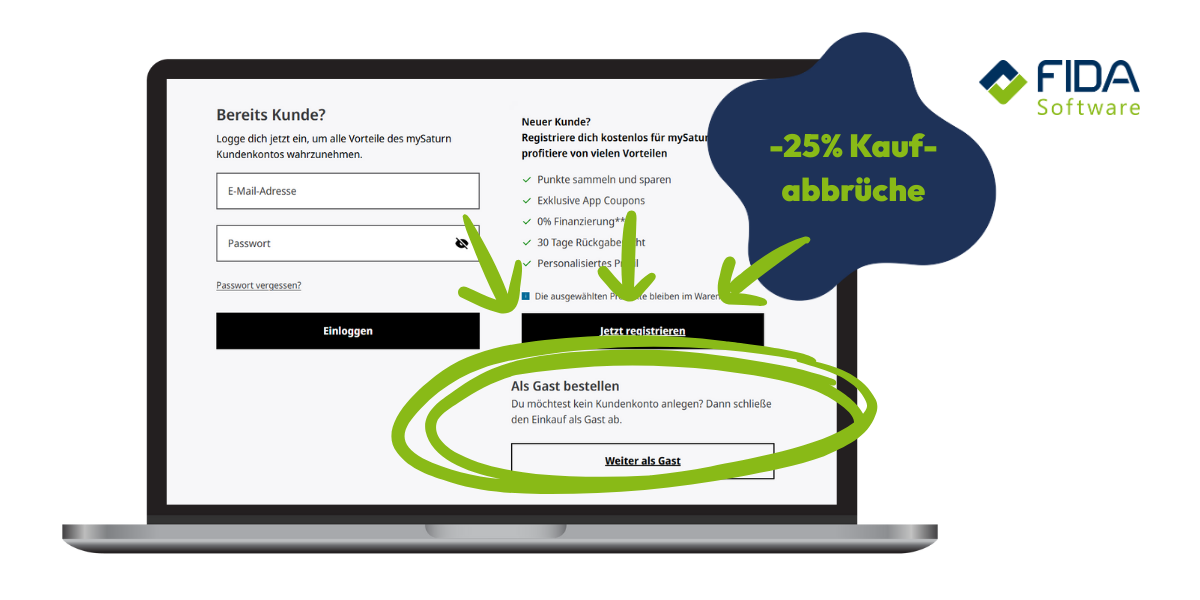
The 4 UX pillars: Usefulness, usability, aesthetics, accessibility
A convincing user experience is based on clearly defined quality features. Four aspects are particularly relevant:
Usefulness - relevance before functionality
A product can work technically flawlessly - but if it does not offer any real added value, it will hardly be used. Usefulness means fulfilling specific needs and solving real problems. This goal requires a deep understanding of the target group, their usage contexts, tasks and expectations.Usability - simplicity of use
Usability describes how easy and efficient a product is to use. Users should be able to find their way around intuitively, without long explanations or training. Good usability means guiding users logically through tasks, avoiding unnecessary complexity and supporting them in recognizing and correcting errors. Usability is a central element of the user experience, as it has a significant influence on the satisfaction and success of a product.Aesthetics - design that builds trust
Visual design is more than just a question of appearance. An appealing appearance signals quality and professionalism. Studies show that users often perceive well-designed interfaces as more functional - even with technically identical products. Aesthetics therefore contribute directly to the positive perception of the UX.Accessibility - usable for everyone
A product should be accessible regardless of age, experience or limitations. Accessibility includes screen reader compatibility, keyboard navigation and sufficient contrast.Since June 28, 2025, it has been mandatory for many digital B2C offerings - such as websites, apps, online stores and digital services - as a result of the Barrierefreiheitsstärkungsgesetz (BFSG). Established standards such as WCAG 2.1 (AA), EN 301 549 and BITV 2.0 form the basis.
Tools such as WAVE, axe DevTools, Contrast Checker or screen reader tests (NVDA, VoiceOver, JAWS) help with implementation.
Accessibility is therefore not just a legal factor, but a central component of a good user experience. Knowledge of accessibility and usability standards is essential for designers to create a truly accessible and user-friendly solution.
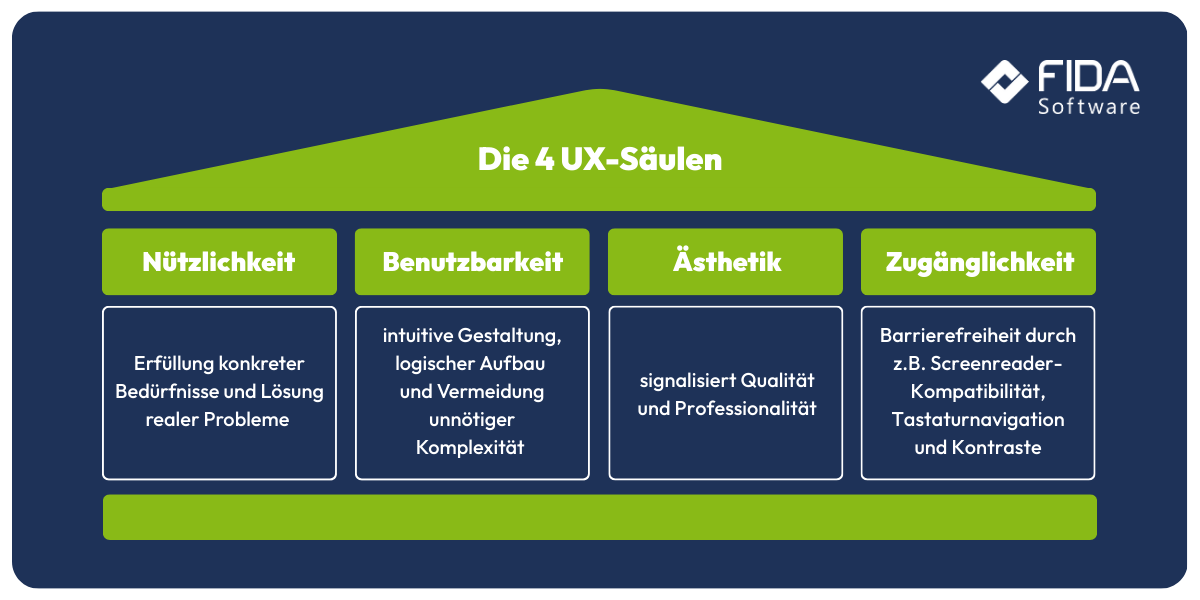
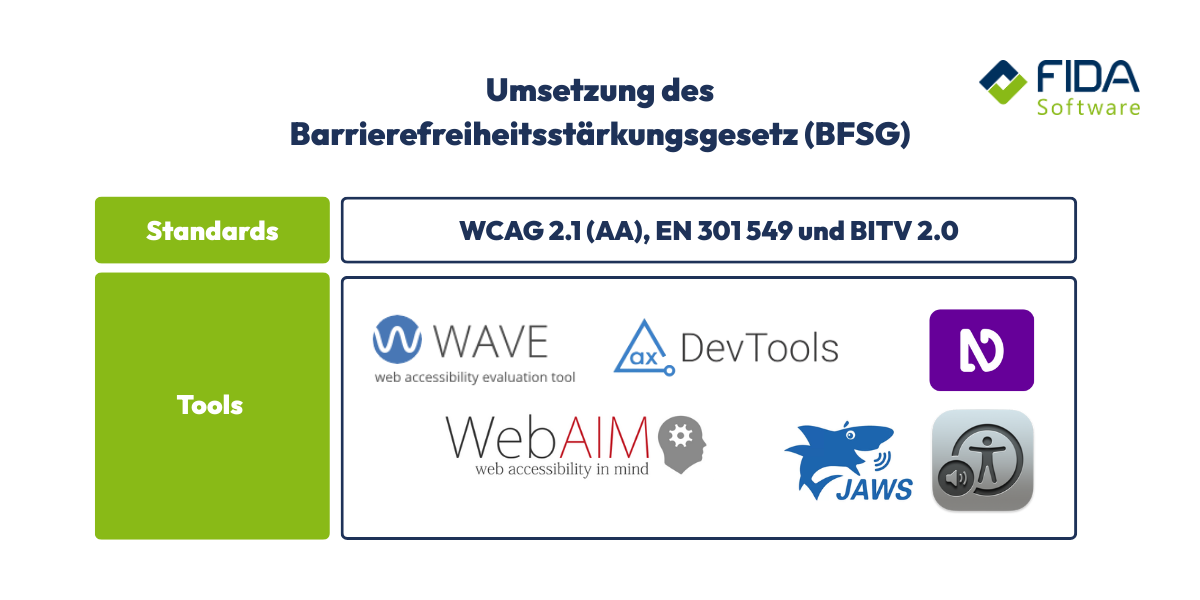
Avoid UX mistakes: Common stumbling blocks & best practices
Usefulness: Relevance before feature abundance
Problem: Development without a sound understanding of real user needs.
Consequence: Existing functions are not used.
Tip: Involve user research at an early stage - for example through interviews, surveys or user tests.
No error-proof operation
Problem: Too many functions or inconsistent navigation.
Consequence: excessive demands, abandonment or increased errors.
Tip: Carry out a task analysis and consistently reduce to the essentials ("less is more").
Neglected visual design (aesthetics)
Problem: Functionality available, but visually unattractive or outdated.
Consequence: Negative first impression, lack of trust.
Tip: Uniform design system, clear visual hierarchy, high-quality typography and color scheme.
Lack of accessibility (accessibility)
Problem: Content cannot be controlled via keyboard or is designed with low contrast.
Consequence: Exclusion of certain user groups, e.g. older people or people with visual impairments.
Tip: Observe accessibility standards (e.g. WCAG 2.1 or BITV 2.0) and integrate accessibility checks into the design process.
With us, you can ensure that you don't make any of these mistakes. We help you ensure that your UI/UX design is clear, intuitive and user-friendly right from the start. This prevents complicated processes, confusing navigation or a lack of user guidance - and ensures that your customers remain satisfied.
The UX process: from research to prototyping to iteration
UX design is much more than the visual design of a user interface - it is a comprehensive process that takes the entire digital user experience into account. The focus is on the people who use the product: their needs, expectations, abilities and emotions.
An effective UX design process begins with an understanding of the context of use. Important questions are:
Who are the users?
What do they want to achieve?
What challenges do they face during use?
Methods such as user interviews, context analyses, surveys or observations are used to answer these questions. The aim is to obtain as accurate a picture as possible of the actual requirements - beyond assumptions or purely business perspectives.
Based on these findings, personas, user journeys and scenarios are created, which serve as the basis for the concept. Initial ideas are transformed into wireframes, mockups and prototypes, which are then tested with real users and iteratively optimized.
UX design is therefore not just about designing something, but above all about solving a problem - with a clear focus on user-friendliness, goal achievement and emotional quality.
There is often close collaboration with UI designers, developers and product managers in order to harmonize technical feasibility and strategic goals.
A successful UX design can be recognized by the fact that users have to think as little as possible about the interface and can concentrate fully on their task.
User research: methods, tools & practical examples
User research is the foundation of any successful UX strategy. Only those who know the actual needs, behaviors and expectations of users can design products that are relevant, intuitive and convincing. UX is not a guessing game - sound findings are the basis.
Qualitative vs. quantitative: when to use which method?
UX research can be roughly divided into two categories:
Qualitative methods provide deep insights into mindsets, motivations and problems. They answer thewhybehind user behavior.
Quantitative methods capture behavior in numbers and statistically validate trends. They answer thewhat,how oftenandhow many.
Overview of common methods
Interviews: Direct discussions with users to explore needs, expectations and experiences.
Surveys: Standardized data collection, ideal for larger samples.
Usability tests: Observation of real users performing specific tasks in order to identify weaknesses and potential for optimization.
Contextual inquiry: Observation and questioning of users in the actual context of use.
Card sorting: Method for developing intuitive navigation structures.
A/B tests: Comparison of two variants of a solution in live operation with measurable results.
Heatmaps & session recordings: Visualization of click, scroll and exit behavior on a website.
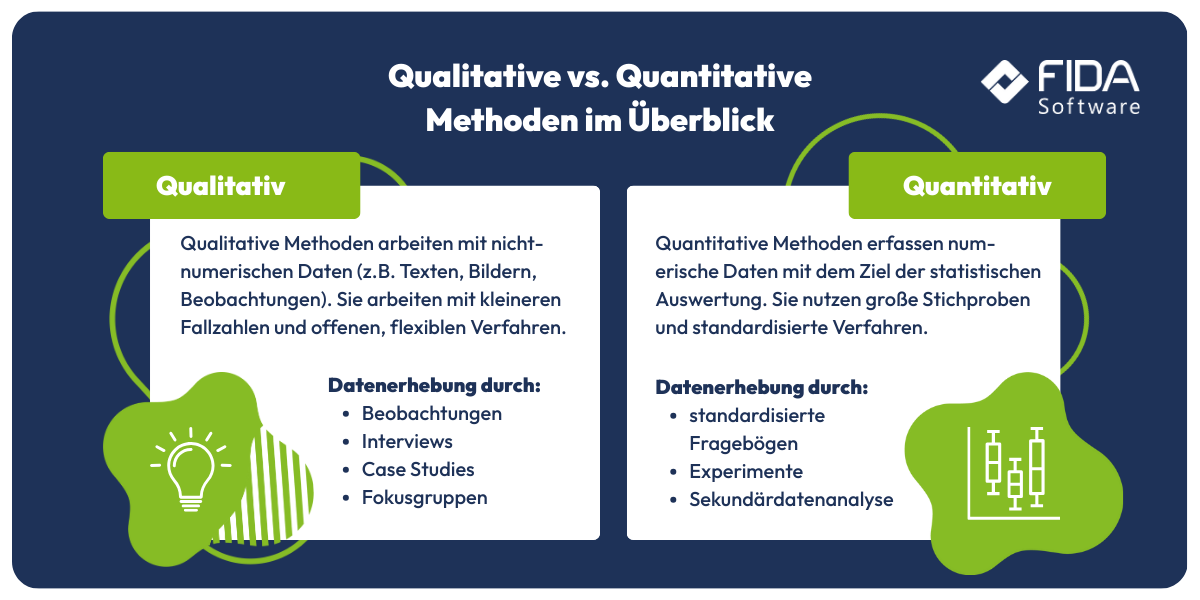
Tools to support UX research
Hotjar, Clarity, Crazy Egg - heat maps and behavior recordings.
Maze, Optimal Workshop, UsabilityHub - remote testing, card sorting, testing design decisions.
Typeform, SurveyMonkey, Google Forms - Design and evaluation of surveys.
Lookback, UserZoom, Dovetail - remote interviews, session recordings, documentation of findings.
Why user research is indispensable
In practice, it often turns out that what seems logical to the development team often works quite differently for real users. User research creates empathy, disproves assumptions and ensures that UX decisions are based on real needs - not opinions.
We guide you through the entire UX and UI process - from the initial research phase to prototyping and testing. In this way, we ensure that every decision is based on real user needs and that your digital product is optimized step by step.

Personas & user journeys: making target groups tangible
In order to consistently focus on users, it is not enough to simply collect data. You need a tangible picture of the people for whom a product is being developed. Two central tools in UX design are personas and user journeys.
Personas - representative user models
Personas are fictitious but realistic user profiles based on data from user research. They represent typical representatives of the target group - including their goals, needs, behavioral patterns and potential challenges during use.
A good persona contains, among other things:
Name, age, profession (fictitious)
Goals and tasks in the context of the product
Expectations, frustrations and needs
Technical affinity and preferred devices
Quotes or statements that clarify the mindset
Goal: Personas make abstract target groups tangible. They help design teams and stakeholders to put themselves in the shoes of real users and incorporate their perspective into decisions - especially during team discussions.
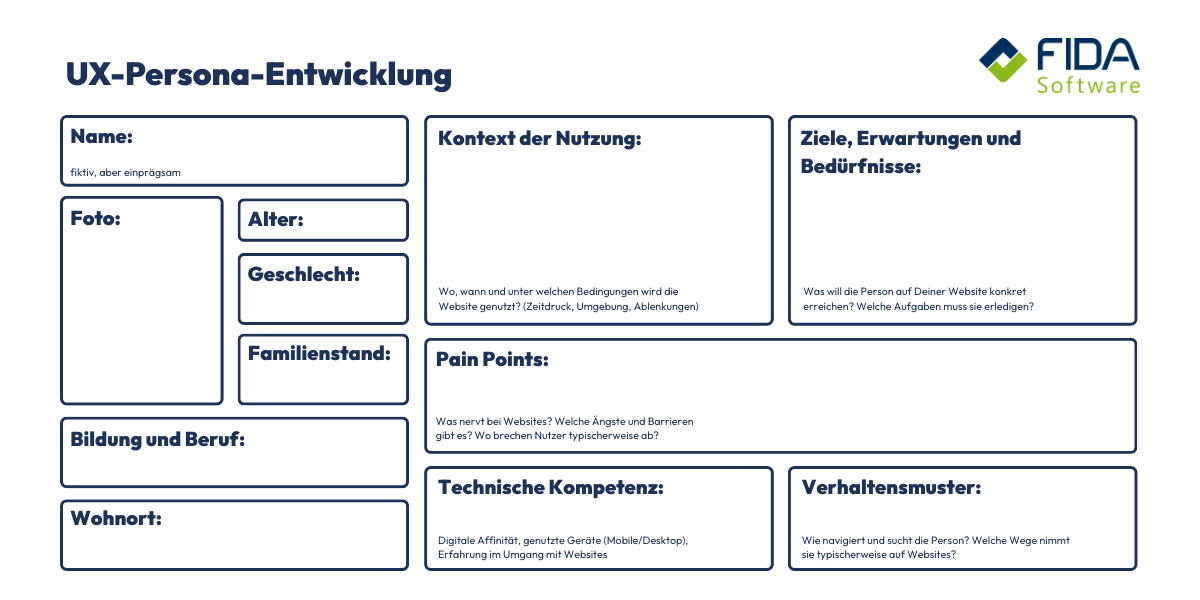
User journeys - understanding the user journey
User journeys or the user journeys map visualize the path that a user takes within a product to achieve a specific goal - e.g. opening an account, completing an order or reporting a problem.
A typical journey shows:
The individual steps (touchpoints)
Emotional states of the user per step
Expectations, questions or uncertainties
Potential barriers or points of frustration
Goal: User journeys help to identify critical moments in the user experience and improve them in a targeted manner - for example through better assistance, shorter processes or clearer communication.
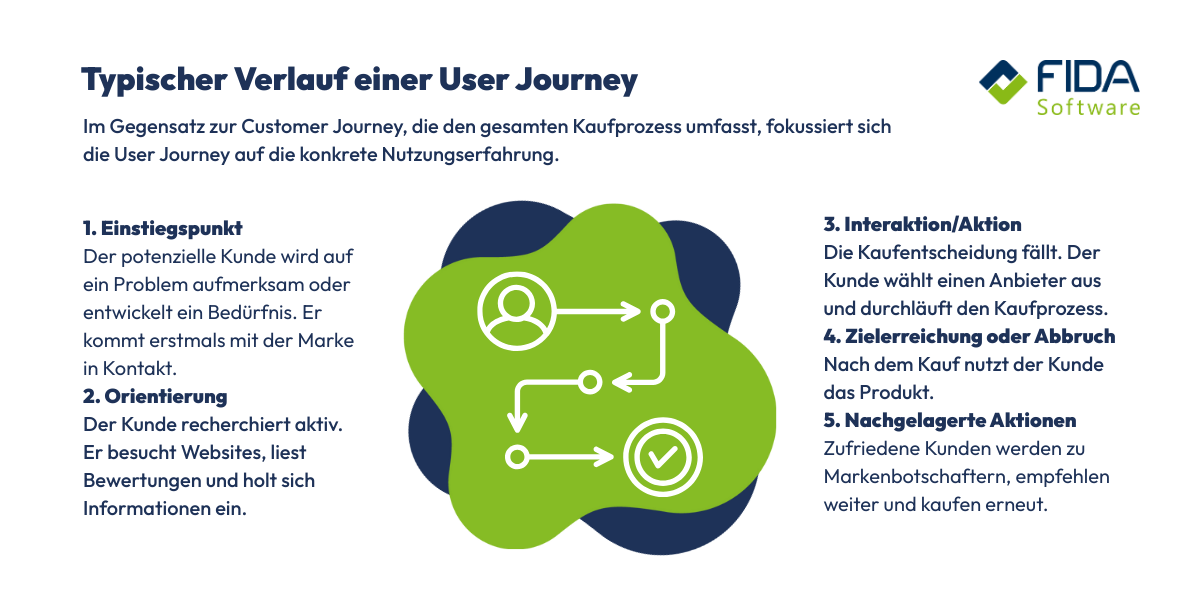
Interaction of personas and user journeys
When used in combination, these methods enable a detailed understanding ofwhodoes something,whyit is done - and where problems or potentials lie.
They are indispensable tools for user-centered and effective UX concepts.
Usability tests: planning, implementation & evaluation
Usability testing is one of the most effective ways to determine how understandable, efficient and satisfying a digital product actually is. Instead of relying on assumptions or internal opinions, these tests show how real users interact with the system - including stumbling blocks, misunderstandings and unexpected behavior.
Why usability testing is essential
Even carefully designed concepts can fail in practice if users interpret them differently than planned. Usability tests help to identify such gaps at an early stage - before considerable time and money is invested in the final implementation. They are a central element of every user-centered design process.
Usability test procedure
A typical test comprises the following steps:
Target definition: determine what is to be tested (e.g. navigation, registration, checkout process).
Selection of participants: Recruit representative users, ideally based on the personas created.
Formulate test scenarios: Concrete tasks that users should solve in the test (e.g. "Find the return form").
Observation & documentation: Analyze the interactions, ideally using theThinking Aloud method.
Evaluation & deductions: Identification of error sources, barriers and optimization opportunities.
Success factors for usability tests
Neutrality: Test managers should not intervene in order not to falsify results.
Realistic test environment: Use of the end devices and contexts in which the product is actually used.
Small samples are sufficient: Just 5-7 users can uncover over 80% of usability problems (Jakob Nielsen).
Iteration: Tests are not one-off events, but part of an ongoing optimization process.
Tools for remote usability tests
Lookback, UserTesting, Maze, PlaybookUX - platforms for video tests, interviews and tasks.
FigJam, Miro - for collaborative analysis and follow-up.
Motional UX: psychology, microinteractions & trust
UX design is not only aimed at functionality and usability, but also at creating positive emotional experiences.
Users do not only decide rationally whether they like or recommend a product - their feelings during use play a key role.
The importance of emotions in UX
Emotions work faster than logical considerations. Within milliseconds, the brain decides whether a product appears appealing and whether the interaction will be continued.
A smoothly functioning product may be efficient, but it remains interchangeable. Emotional design, on the other hand, anchors experiences in the memory.
Examples:
Friendly microtexts ("You've almost done it!") generate motivation.
Gentle animations at the end of a task trigger joy.
Clear, empathetic error messages create trust.
Psychological principles in the UX
Hick's Law: Less choice speeds up decisions.
Fitts' Law: Proximity and size of interaction elements influence usability.
Peak-end rule: Users remember the emotional peak and the end of an interaction in particular.
Reciprocity effect: Small "gifts" such as free trial periods encourage positive reactions.
Conclusion:In saturated markets, emotional factors often determine success. Design, tonality, animations and micro-interactions create loyalty and trust.
UX consulting: services, process & added value for companies
With our UX consulting, we support you in strategically and methodically optimizing the user experience of your digital products. Our experts bring an independent perspective, in-depth expertise and a structured approach to identify weaknesses and implement concrete improvements. This ensures that your users remain enthusiastic - from the first click to the last step in the process.
Typical services
UX audits and heuristic evaluation of existing products
User research and target group analysis
Introduction of user-centered processes
Support for new developments or relaunches
Training teams in UX methods and tools
Our UX consulting is particularly worthwhile if there is little internal UX expertise, digital products are stagnating or recurring user feedback points to problems.
It is not a one-off workshop, but can act as a strategic partner over time - for better decisions and sustainable results.
UX strategy: vision, KPIs & anchoring in the product process
A UX strategy is the long-term plan for how a company systematically ensures a consistent, value-adding user experience - aligned with business goals, user needs and technical framework conditions. It combines vision, target group understanding and concrete UX measures.
Key elements of a UX strategy
Definition of a UX vision: Long-term target image of the user experience
User research & segmentation: Precise knowledge of the core target groups
UX goals and KPIs: measurable key performance indicators
Integration into product development processes: Regular integration of UX
Building UX expertise and culture: training, standards, tools, roles
Without a clear strategy, UX often remains reactive. With a well thought-out UX strategy, it becomes proactive, measurable and controllable - and helps to set well-founded priorities.
What is user interface design - elements, patterns & design systems?
The user interface is the visual and functional interface between a person and a digital product. It is the area that users see, touch and operate. A well-designed UI guides users intuitively through processes, communicates states clearly and supports them in achieving their goals.
Components of the UI
Buttons, forms, sliders and menus
Layouts, color schemes, typography and icons
Animations, transitions and visual feedback
A professionally designed UI not only conveys information, but also mood, style and brand identity.
UX vs. UI: differences, interaction & examples
Although UX and UI are often referred to together, they are different disciplines:
Although UX and UI are often mentioned in the same breath, they are two different but closely interlinked disciplines. While UX (user experience design) focuses on the overall experience, i.e. how a product feels, how intuitive it is to use and whether users achieve their goals efficiently, UI (user interface design) deals with the visual and functional design of the interface.
UX is strongly based on research, user needs and behavioral analysis, whereas UI is based on aesthetics, brand identity and a consistent design system. Only when they work together do digital products emerge that not only look good, but are also popular and successfully used.
Simplified metaphor:
UX = the "feeling" when visiting a restaurant (reservation, atmosphere, service).
UI = the "table setting" (menu, plates, cutlery, arrangement).
Only the interaction of both disciplines creates a holistic and convincing user experience.
7 principles of good UI design: consistency, hierarchy & feedback
Consistency: Recurring elements help users to find their way around more quickly.
Visual hierarchy: Important content is highlighted by size, color, position or contrast.
Feedback: Every interaction receives clear visual or acoustic feedback.
Affordance: Elements show how they can be used through their design.
Error tolerance: Design prevents errors or makes it easy to correct them.
Accessibility: UI is accessible for all user groups.
Simplicity/reduction: focus on the essentials, avoid unnecessary elements.
These principles not only ensure a visually appealing design, but also effective and inclusive use.
UX/UI designer: tasks, skills & tools
UX/UI designers build the bridge between users and digital products. They ensure that applications not only look good, but are also intuitive, understandable and effective. Their task is to translate user needs into concrete, functional and aesthetic solutions.
Two roles, often combined in one position
In many companies, the position of UX/UI designer is seen as a combination role - in other words, someone who designs both the user experience (UX) and the visual interface (UI).
In larger teams, UX and UI are often separate, while in smaller projects one person takes on both tasks.
Activities in the UX area
Conducting user research (interviews, surveys, tests)
Developing personas, user journeys and information architectures
Conception of user flows and interaction logics
Creation of wireframes and low-fidelity prototypes
Planning and carrying out usability tests
Coordination with product owners, developers and stakeholders
Activities in the UI area
Designing visual interfaces based on the UX concept
Selection of colors, typography, icons and UI elements
Creation of high-fidelity designs and interactive prototypes (e.g. in Figma)
Development and maintenance of design systems
Ensuring consistency and accessibility
Handing over designs to developers (e.g. via style guides)
Soft skills and tools
Good UX/UI designers combine creative and analytical skills with empathy, strong communication skills and technical understanding.
Typical tools include:
Figma, Sketch, Adobe XD (UI design & prototyping)
Miro, FigJam (workshops, user journeys, ideation)
Maze, Lookback, Hotjar (user research and testing)
Goal: A product that is not only visually appealing, but also functional, easy to understand and a pleasure to use.
Conclusion: Why UI/UX determines product success
Good UX/UI design is far more than just an aesthetic detail - it determines how your users feel in a digital product, how efficiently they achieve their goals and whether they recommend your product to others. If you consistently focus on the needs of your users and use design strategically, you will create experiences that not only work, but also inspire.
UX and UI are not isolated disciplines. At FIDA, we support you in integrating them into your projects at an early stage, continuously and holistically. With sound user research, a clear UX strategy and a well thought-out interface, we ensure that these elements do not remain "nice-to-have" options, but become real competitive advantages in the digital world.
FAQ - What does UI/UX design mean?
UX (user experience) encompasses the entire user experience of a product - i.e. how intuitive, efficient and satisfying an application is. UI (user interface), on the other hand, focuses on the visual and interactive design of the interface - such as layout, colors, fonts, buttons, icons and feedback mechanisms. Both disciplines work closely together, but with different focuses.
Four central quality features are important:
Usefulness (relevance to user needs)
Usability (user-friendliness and efficiency of operation)
Aesthetics (visual design that creates trust)
Accessibility (products should be usable regardless of age or disability)
Essential UI principles are:
Consistency in design and operation to create familiarity
Visual hierarchy to highlight important content
Feedback during interactions so that users know what is happening
Affordance: design that makes it clear how elements can be used
Error tolerance so that users can easily correct mistakes
Accessibility so that all user groups can be integrated
Simplicity/reduction: focus on the essentials, without unnecessary complexity
User research forms the foundation. This includes interviews, surveys, observations, target group analyses and the creation of personas and user journeys. These methods help to make real needs, expectations and usage situations visible and avoid assumptions.
Emotions strongly influence how users perceive a digital product and whether they continue to use it or recommend it to others. Micro-interactions, friendly texts, animations or empathetic error messages can generate positive feelings and significantly improve the user experience. Principles such as Hick's Law, Fitts' Law and the Peak-End Rule help to consciously design emotional experiences.
The process of a usability test includes
Target definition: Determine which aspects are to be tested
Participants: Select representative users (e.g. based on personas)
Formulate scenarios/tasks: Determine typical user tasks
Implementation & observation: Observe users with real devices and context
Evaluation: Identify weak points and derive improvements
Repetition/iteration: Repeat test rules regularly in order to continuously optimize
A sustainable UX strategy contains
a UX vision that defines the experience to be achieved in the long term
clear UX goals and measurable KPIs to make success and progress visible
user research and segmentation in order to know target groups precisely and act accordingly
integrating UX into development processes so that UX is not an afterthought, but is considered from the outset
Building UX expertise and culture within the company - e.g. through training, standards and tools
A typical process has the following phases:
Analysis & research (users, context, requirements)
Conception (personas, user journeys, information architecture, user flows)
Design & prototyping (wireframes, mockups, high-fidelity designs)
Usability testing and feedback rounds to check real user experiences and eliminate weaknesses
Iteration & adaptation: Revise, optimize and test again after testing
